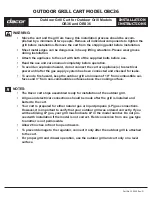
GASGUARD IS CONTROLLER Issue: R2, Date: 26/09/2011, CRN: 7502
Page 17
The following information should be understood to ensure that the Controller reliably signals alarm
states at appropriate levels. Failure to observe correct settings may result in system alarm failure.
2.8
Setting Alarm Set-Points
There are five available alarm set-points per channel, giving a total of 20 alarm signals. The available alarms cover
high fault, low fault and three process level alarms. Each channel’s alarm group is independent of other channels.
The high and low fault alarms are active for process signals that rise above or drop below the baseline ‘zero. The
high and low alarm threshold points are set in terms of input milliamps. The high fault and low fault alarms are
named ‘HF’ and ‘LF’ respectively in the menu system.
The process level alarms, named A1, A2, and A3, are configurable based on the units set for that channel. Each
alarm may be set to trip based on an input signal’s ‘position’ relative to the set-point (i.e. input above set-point, or
input below set-point).
Note: Alarms that activate above or below a user set threshold are often referred to as ‘rising’ or ‘falling’
alarms. For the Gasguard controller, alarms become active only when an input crosses the set threshold.
An alarm is not activated by sensing a change in signal direction, or by a rate of change of input signal level.
The following alarm parameters may be set by the user:-
•
LF alarm level (in mA, 0 to 99.99)
•
HF alarm level (in mA, 0 to 99.99)
•
A1 alarm level (in process units, pos/neg value, 0 to value scaled by decimal place setting)
•
A2 alarm level (in process units, pos/neg value, 0 to value scaled by decimal place setting)
•
A3 alarm level (in process units, pos/neg value, 0 to value scaled by decimal place setting)
•
LF alarm direction ( Falling / Rising)
•
HF alarm direction (Falling / Rising)
•
A1 alarm direction (Falling / Rising)
•
A2 alarm direction (Falling / Rising)
•
A3 alarm direction (Falling / Rising)
•
LF alarm latching mode (mask bit, Latch = YES, non-latch = NO)
•
HF alarm latching mode (mask bit, Latch = YES, non-latch = NO)
•
A1 alarm latching mode (mask bit, Latch = YES, non-latch = NO)
•
A2 alarm latching mode (mask bit, Latch = YES, non-latch = NO)
•
A3 alarm latching mode (mask bit, Latch = YES, non-latch = NO)
•
Alarm Delay (in mS, 0 to 9999). Sets time delay from process input matching set threshold, to alarm signal becoming
active. Operates on any/all 5 channel alarms and is not configurable per individual alarm.
Within each channel, an alarm threshold cannot be set that exceeds the full scale for that channel. The controller
scales all set-point values according to the full scale setting.
For example, a channel with a full scale reading initially set to 1000 and set-point configured to 500, the set-point is
50% of the scale value.
If the channel full scale value is now changed to 2000, the Controller will automatically rescale the trip-point to 1000.
This maintains the trip point at the same proportion of full scale ( 50% in this example).
Summary of Contents for gasguard
Page 47: ...GASGUARD IS CONTROLLER Issue R2 Date 26 09 2011 CRN 7502 Page 46 ...
Page 62: ...GASGUARD IS CONTROLLER Issue R2 Date 26 09 2011 CRN 7502 Page 61 B2 Main Menu Flowchart ...
Page 63: ...GASGUARD IS CONTROLLER Issue R2 Date 26 09 2011 CRN 7502 Page 62 B3 Calibration Flowchart ...
Page 64: ...GASGUARD IS CONTROLLER Issue R2 Date 26 09 2011 CRN 7502 Page 63 B4 Configuration Flowchart ...
Page 74: ...GASGUARD IS CONTROLLER Issue R2 Date 26 09 2011 CRN 7502 Page 73 Appendix C Approvals ...
Page 75: ...GASGUARD IS CONTROLLER Issue R2 Date 26 09 2011 CRN 7502 Page 74 ...
Page 76: ...GASGUARD IS CONTROLLER Issue R2 Date 26 09 2011 CRN 7502 Page 75 ...
Page 77: ...GASGUARD IS CONTROLLER Issue R2 Date 26 09 2011 CRN 7502 Page 76 ...
Page 78: ...GASGUARD IS CONTROLLER Issue R2 Date 26 09 2011 CRN 7502 Page 77 ...
Page 79: ...GASGUARD IS CONTROLLER Issue R2 Date 26 09 2011 CRN 7502 Page 78 ...
















































